![]()
![]()
![]()
Use LEFT and RIGHT arrow keys to navigate between flashcards;
Use UP and DOWN arrow keys to flip the card;
H to show hint;
A reads text to speech;
58 Cards in this Set
- Front
- Back
|
What are nares? |
Nostrils - anterior nasal openings |
|
|
What are choanae? |
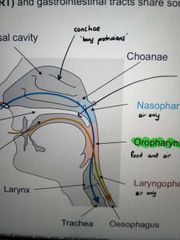
The interior nasal openings at the back of the nasal cavity |
|
|
What are conchae? How many are there? |
Bony protrusions of the lateral nasal cavity wall that provide a larger surface area of the nasal cavity. There are 3: superior, middle and inferior |
|
|
What are the 3 regions of the pharynx? What passes through each region? |
Nasopharynx - air Oropharynx - air and food Laryngopharynx - air |
|
|
What separates the oral cavity from the nasal cavity? |
Hard palate anteriorly, soft palate posteriorly |
|
|
What separates the frontal and parietal bones? |
Coronal suture |
|
|
What separates the two parietal bones? |
Saggital suture |
|
|
What is the bregma? |
The point of fusion of the frontal bone and the two parietal bones |
|
|
What separates the parietal bones from the occipital bone? |
The lambdoid suture |
|
|
What is the lambda? |
The point of articulation between the two parietal bones and the occipital bone |
|
|
What is the pterion? Why is it clinically important? |
A region of close articulation between frontal, parietal, temporal and sphenoid bones. The middle meningeal artery runs up the inside of the cranium at this point, and a blow to the side of the head can damage it |
|
|
What are fontanelles? |
Regions of unfused bone in newborn babies |
|
|
When does the anterior fontanelle fuse? |
Around 18 months |
|
|
When does the posterior fontanelle fuse? |
Around 3 months |
|
|
What is the metopic suture? Where does it come from? |
A midline suture down the middle of the frontal bone, caused by incomplete fusion of the two ossification centres that form the frontal bone |
|
|
Which structures mark the anteroposterior boundaries of the nasal cavity? |
Nares and choanae |
|
|
What are the four paranasal air sinuses? |
Frontal air sinuses (x2) Sphenoid air sinuses (x2, may be Fused) Maxillary sinuses (x2) Ethmoid "air cells" (multiple) |
|
|
Draw a diagram showing the relationship of the paranasal air sinuses to the nasal cavity |
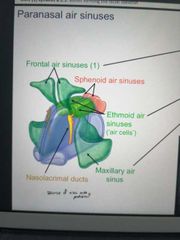
|
|
|
What is the lamina papyracea? Why is it clinically important? |
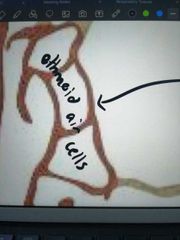
The very thin plate of bone separating the lateral ethmoid sinuses and the medial orbit. Infection of the ethmoid air cells can easily spread to the eyes and cause orbital cellulitis |
|
|
Which bone provides the superior and middle conchae? |
Ethmoid bone |
|
|
Which bone supplies the Inferior concha? |
None, it is its own bone |
|
|
What are the names for the spaces beneath each concha? |
Inferior/middle/superior meatus |
|
|
Which two bones makes up the hard palate? |
Maxillary bone anteriorly, palatine bone posteriorly |
|
|
Draw a saggital view of the nasal septum, indicating the bones that contribute to it |
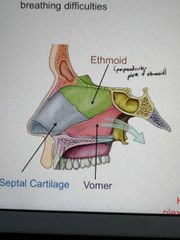
|
|
|
What is the arterial supply to the nasal septum? Where do nosebleeds come from? |
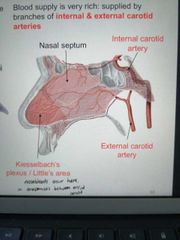
An anastamosis of the internal and external carotid artery. Nosebleeds occur in Little's area |
|
|
What are nasal polyps and why are they a problem? |
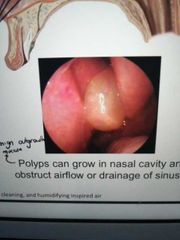
Benign outgrowths of nasal mucosa that can lead to obstructed airflow or sinus drainage |
|
|
Which 3 nerves innervate the nasal cavity? Give their names and numbers? |
CN1 - Olfactory nerve CN5 - Trigeminal nerve CN7 - Facial Nerve |
|
|
What does CN1 supply to the nasal cavity? |
Special sense of smell |
|
|
What does CN5 supply to the nasal cavity? How does it do this? |
Somatic sensation. Anterosuperior portion supplied by ophthalmic division (5a). Posteroinferior supplied by maxillary division (5b) |
|
|
Which CN supplies the air sinuses and what is the exception? |
Ophpalmic division of Trigeminal (Va) except the maxillary sinus, which is innervated by maxillary division (Vb) |
|
|
Which sinuses drain above the superior concha? |
Sphenoid sinus |
|
|
Which sinuses drain beneath the superior concha? |
Posterior ethmoidal air cells |
|
|
Which sinuses drain beneath middle concha? |
Middle/anterior ethmoidal air cells, frontal sinus, maxillary sinus |
|
|
What is special about sinus drainage of the maxillary duct? |
It drains into a structure called the semilunar hiatus |
|
|
What sinus drains beneath the Inferior concha? |
None, but the nasolacrimal ducts do |
|
|
What is a eustachian canal and where is it located? |
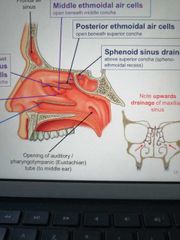
A canal between the nasal cavity and middle ear |
|
|
What spinal level does the hyoid bone sit? |
C3 |
|
|
What spinal level does the thyroid cartilage sit? |
C5 |
|
|
What spinal level does the cricoid cartilage sit? |
C6/7 |
|
|
What connects the hyoid to the thyroid cartilage? |
Thyrohyoid membrane |
|
|
What connects the thyroid to the cricoid cartilage? What is the clinical importance of this? |
Cricothyroid membrane. Can be cut to provide emergency airway access if upper airway is blocked |
|
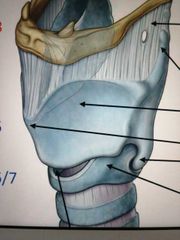
Describe the features of the thyroid cartilage
|
Superior hornLamina (flat region)Laryngeal prominence (Adams apple)Inferior horn (articulates with cricoid) |
|
|
What are the aretynoid cartilages? |
Small cartilages that articulate with the superior cricoid and the vocal cords. When these change position, the vocal cords also change |
|
|
What are the two processes of the arytenoid cartilages? |
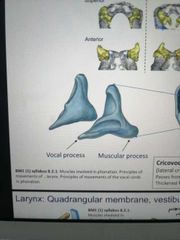
Muscular (posterior) Vocal (anterior) |
|
|
What is the cricovocal membrane? |
An elastic membrane that connects the vocal cord to the superior edge of cricoid - the vocal ligaments are really just a thickened free edge of this membrane |
|
|
What is the quadrangular membrane and where does it pass between? |
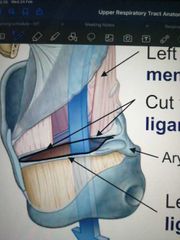
A membrane that passes between the lateral edge of the epiglottis and the anterolateral edge of the arytenoid. Its thickened Inferior edge forms the vestibular ligament, or false vocal cord |
|
|
What is the vestibule? |
The part of the laryngeal cavity between the inlet and the vestibular folds. |
|
|
What is the laryngeal ventricle? |

An outfolding of mucosa that bulges out between the vestibular and vocal ligaments. Otherwise known as a mucosal pouch |
|
|
What is the rima glottidis? |
The gap between the vocal folds |
|
|
What is the glottis? |
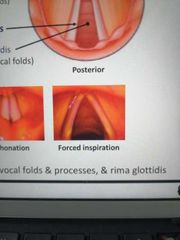
The vocal folds and their processes, as well as the rima glottidis |
|
|
Name all the muscles involved in movement of the vocal cords. Draw a diagram showing them |
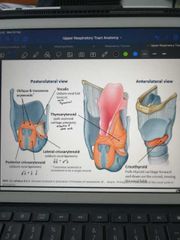
Oblique arytenoids (x2) Transverse arytenoid Posterior cricoarytenoid (x2) Lateral cricoarytenoid (x2) Vocalis (x2) Thyroarytenoid (x2) Cricothyroid (x2) |
|
|
What is the function of the oblique and transverse arytenoids? |
Contract to bring arytenoid cartilages (and so vocal cords) closer together |
|
|
What is the function of the posterior cricoarytenoids? |
To abduct the vocal ligaments |
|
|
What is the purpose of the lateral cricoarytenoids? |
To adduct the vocal ligaments |
|
|
What is the purpose of Thyroarytenoid and vocalis? |
To pull the arytenoid cartilage anteriorly and slacken the vocal cords |
|
|
What is the purpose of Cricothyroid? |
To pull the thyroid cartilage down and forward on the cricoid, tensing the vocal cords |
|
|
How is the Larynx innervated? |
Entirely from vagus nerve - superior laryngeal nerve supplies mucosal sensation above vocal folds, as well as Cricothyroid muscle - Inferior (recurrent) laryngeal nerve supplies mucosal sensation below vocal folds, and all other laryngeal muscles apart from cricothyroid |
|
|
What are piriform fossae and what is their clinical signifance? |
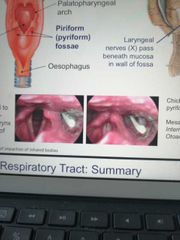
Mucosal recesses lying posterolateral to the laryngeal opening. They form pockets into which ingested objects may fall. This is dangerous because the Inferior laryngeal nerve runs up the wall of the piriform fossa and can be damaged by foreign objects, leading to possible paralysis of all laryngeal muscles, eg chicken bone |

